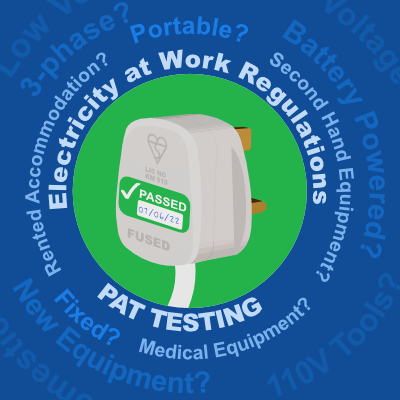PAT Testing: Understanding Its Scope and Exceptions

Portable Appliance Testing (PAT), originated as a method to comply with the Electricity at Work Regulations 1989. It has now become an important part of electrical safety in the UK. The Institute of Electrical Engineers (IEE) published the first Code of Practice for In-service Inspection and Testing of Electrical Equipment in 1994. This Code of Practice provides overall guidance on how the inspection and testing should be carried out.
The term 'Portable Appliance Testing (PAT), has become the unofficial term for describing the inspection and testing process and unfortunately, this leads to confusion about the type of equipment that it covers.
What Falls Under PAT Testing?
PAT testing extends to any electrical equipment operating between 50V and 1,000V ac, that is connected or could be connected to the electrical supply within a workplace. This covers everything from a mobile phone charger plugged into a socket to a 3-phase machine directly wired to the electrical supply.
What's Exempt from PAT Testing?
The fixed wiring system, which includes permanent electrical components like light fixtures and sockets, is not subjected to PAT testing. Instead, this system falls under a different procedure known as Periodic Inspection and Testing.
PAT testing is not suitable for equipment operating above 1,000 Vac. Additionally, extra low voltage equipment, operating at or below 50Vac or 120Vdc, typically doesn't require testing, though a visual inspection may be necessary in certain hazardous environments.
Brand new electrical equipment doesn't require PAT testing. Manufacturers and suppliers have a responsibility to ensure the equipment is safe for use according to UK standards. New electrical equipment must be marked with a UKCA label to confirm that it meets these standards. However, once in use, regular PAT testing becomes necessary to ensure continuous safety.
Medical equipment, due to its unique nature, undergoes a different testing procedure according to IEC 62353, which involves measuring the leakage current on parts connected directly to the patient.
Beyond the Workplace
Although initially designed for maintaining electrical equipment within the workplace, PAT testing has now expanded into other areas.
For second-hand electrical equipment, PAT testing is the recommended method of ensuring equipment is safe and suitable for resale.
Similarly, PAT testing is commonplace in rented accommodation, where landlords bear the responsibility for ensuring all electrical appliances supplied under the rental agreement are safe for tenant use.
Conclusion
While the term 'PAT testing' may lead to some confusion, its role in ensuring electrical safety remains undeniably important. Regardless of the context, whether it's a workplace, second-hand shop, or rented accommodation, the significance of regular inspection and testing of electrical appliances is paramount. Our training courses provide the knowledge and hands-on experience in PAT testing. They are designed to clarify any confusion about the process and ensure that testing is conducted effectively and safely.